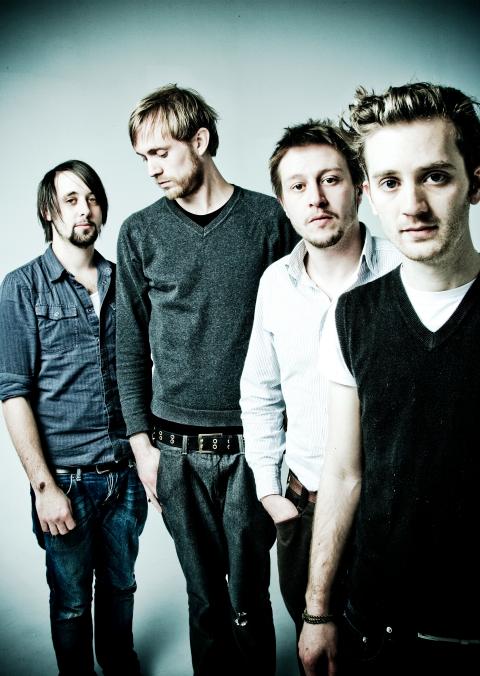Post-rock often conjures up images of scruffy college-age musicians performing instrumental rock music for college-age fans, heads bowed, bobbing to slow-starting grooves that build into epic jams laden with electric guitar effects and crashing cymbals that later dissolve into quiet, ambient sounds.
It’s tempting to use this description for 65daysofstatic, the British band that’s headlining the Megaport Music Festival in Kaohsiung on Sunday and plays at The Wall (這牆) in Taipei on Tuesday.
But 28-year-old guitarist Joe Shrewsbury, who says his band has never called its music “post-rock,” isn’t crazy about the term.

Photo courtesy of The Wall
“Post-rock has a real stigma to it these days,” he wrote in an e-mail interview with the Taipei Times. The genre, Shrewsbury says, “seems to have murkier connotations with dark rooms and riffs, and artwork with allusions to the fall of the Roman Empire or whatnot.”
“It doesn’t summon images of incredibly healthy and well kempt young men, lithely playing gripping and phenomenally exciting instrumental music that can be danced to until you can’t stand up,” he added.
Indeed, the four-piece band’s music tends to go at a faster pace than most of what’s called “post-punk,” driven by programmed drumbeats and loops.
“A lot of the songs we write do stem from the electronic side of things,” he said. “Because electronics can be so different, and [have such a signature sound], they often dictate the overall feel of a track.”
The band, from Sheffield, broke out in 2004 with The Fall of Math, an album that combined progressive rock with electronica. The tight arrangements and complex rhythm patterns used by the group have also led fans to refer to its music as “math rock.”
65daysofstatic enjoys an avid following in the UK and gained wider exposure as the supporting act for The Cure’s tour of the US in 2008.
The association led to a later collaboration with The Cure’s bandleader, Robert Smith, on Come to Me, a track from 65daysofstatic’s 2010 release We Were Exploding Anyway.
The album is more accessible than the average post-rock album, and Shrewsbury acknowledges that it has a “dancier feel” than the band’s previous recordings. A song like Go Complex could be played at a rave; others such as Dance Dance Dance could be the soundtrack for a video game.
Part of the band’s sense of pop comes from an appreciation of mainstream artists. 65daysofstatic members have remixed and created mash-ups using the music of megastars such as Avril Lavigne, Katy Perry and Justin Timberlake.
“We are always interested in making our music as catchy and accessible and enjoyable as possible,” Shrewsbury said. “So in that sense, ‘pop’ is a huge influence.”
Tiger Girl, a 10-minute track from We Were Exploding, is an example of the band’s balance of post-rock and electro-pop. The song’s melody follows a cinematic arc that ought to be familiar to post-rock listeners, while a thumping techno beat speaks to the dance floor crowd.
Shrewsbury says the songs’ complex arrangements and electronic instruments present a few technical challenges in performing live, but that doesn’t deter the band’s enthusiasm for touring.
“We put everything into playing live, and we love doing it,” he said. “I guess it stays fresh because it’s one of the greatest jobs in the world.”

On April 26, The Lancet published a letter from two doctors at Taichung-based China Medical University Hospital (CMUH) warning that “Taiwan’s Health Care System is on the Brink of Collapse.” The authors said that “Years of policy inaction and mismanagement of resources have led to the National Health Insurance system operating under unsustainable conditions.” The pushback was immediate. Errors in the paper were quickly identified and publicized, to discredit the authors (the hospital apologized). CNA reported that CMUH said the letter described Taiwan in 2021 as having 62 nurses per 10,000 people, when the correct number was 78 nurses per 10,000

As we live longer, our risk of cognitive impairment is increasing. How can we delay the onset of symptoms? Do we have to give up every indulgence or can small changes make a difference? We asked neurologists for tips on how to keep our brains healthy for life. TAKE CARE OF YOUR HEALTH “All of the sensible things that apply to bodily health apply to brain health,” says Suzanne O’Sullivan, a consultant in neurology at the National Hospital for Neurology and Neurosurgery in London, and the author of The Age of Diagnosis. “When you’re 20, you can get away with absolute

May 5 to May 11 What started out as friction between Taiwanese students at Taichung First High School and a Japanese head cook escalated dramatically over the first two weeks of May 1927. It began on April 30 when the cook’s wife knew that lotus starch used in that night’s dinner had rat feces in it, but failed to inform staff until the meal was already prepared. The students believed that her silence was intentional, and filed a complaint. The school’s Japanese administrators sided with the cook’s family, dismissing the students as troublemakers and clamping down on their freedoms — with

As Donald Trump’s executive order in March led to the shuttering of Voice of America (VOA) — the global broadcaster whose roots date back to the fight against Nazi propaganda — he quickly attracted support from figures not used to aligning themselves with any US administration. Trump had ordered the US Agency for Global Media, the federal agency that funds VOA and other groups promoting independent journalism overseas, to be “eliminated to the maximum extent consistent with applicable law.” The decision suddenly halted programming in 49 languages to more than 425 million people. In Moscow, Margarita Simonyan, the hardline editor-in-chief of the